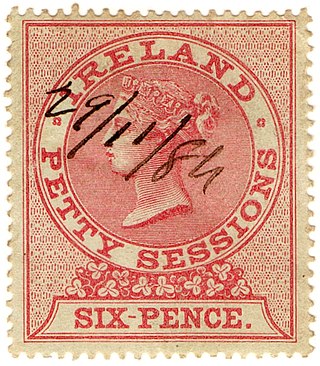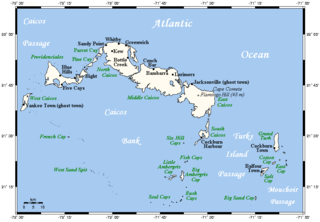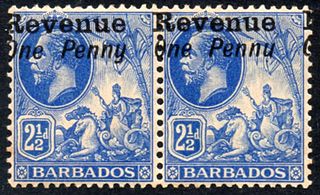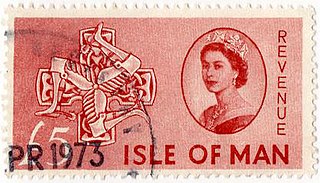Related Research Articles

The postal history of Puerto Rico began around 1518, at least for official mail, when Spain adopted general postal regulations; although the first documentation of Spanish postal regulations specific to the Caribbean was 1794. The first postage stamps were issued 168 years ago for Puerto Rico and Cuba in 1856. Postage stamps just for Puerto Rico followed, and later postal cards and telegraph stamps were issued. United States postal administration began in 1899 and the last stamps specifically for Puerto Rico were issued in 1900. They were superseded by U.S. stamps, which are still used today on the island as it remains a territory serviced by the United States Postal Service (USPS).
The first postage stamps marked Jersey were issued during the occupation of the island by the Germans during World War II.

Revenue stamps of the United Kingdom refer to the various revenue or fiscal stamps, whether adhesive, directly embossed or otherwise, which were issued by and used in the Kingdom of England, the Kingdom of Great Britain, the United Kingdom of Great Britain and Ireland and the United Kingdom of Great Britain and Northern Ireland, from the late 17th century to the present day.

Revenue stamps of Ireland refer to the various revenue or fiscal stamps, whether adhesive, directly embossed or otherwise, which have been used on the island of Ireland since 1774. These include issues by the Kingdom of Ireland, issues by the United Kingdom specifically for use in Ireland or briefly Southern Ireland, and issues of an independent southern Ireland since 1922. Revenue stamps of Northern Ireland were also issued from 1921 to the 1980s, but they are not covered in this article.

The island of Antigua issued revenue stamps from 1870 to 1876. The island's short life as a revenue stamp-issuing country was mainly due to the use of postage stamps for most fiscal purposes from 1862 to 1870, and again from 1890 onwards. Therefore, the only revenues issued are more commonly found mint than used. The first set was issued in 1870 and it consisted of eleven values from 1d to 10s, and four of these values were reprinted in 1876 with a different watermark. This makes a total of just fifteen revenues, with most sought after one being the 10s stamp of 1870.

The Turks and Caicos Islands issued revenue stamps from 1988 to 1998. The Turks and Caicos Islands normally used postage stamps for fiscal purposes, however on 15 December 1988 they issued a $10 value intended for the payment of departure tax. This did not have any wording on it indicating fiscal use and thus was also accepted for postal purposes. Some years later, around 1992, the same design was reissued but inscribed "DEPARTURE TAX" above the country name. In 1998, a new stamp with the face value of $15 was issued commemorating the cable and wireless centenary.

Revenue stamps of the British Solomon Islands, now known as the Solomon Islands, were first issued in around 1926 when the islands were a British protectorate. The only revenue stamps issued by the islands were British embossed adhesives overprinted BRITISH SOLOMON ISLANDS in three lines. Five stamps are recorded: two versions of a 1s value issued in 1926 and 1931, and £5, £10 and £50 values issued in 1964. All are rare and command high prices.

The British Virgin Islands has issued revenue stamps since 1988. The first issue consisted of two values of $25 and $100, which represented the fee for wedding licences. In 1996, a set of three values – of $10, $40 and $50 – was issued with a design showing a bird. The first issue had no imprint date, but the $40 is also known with imprint dates of 1997, 1999 and 2003. A $100 recently was added to the series, and a $500 in 2011.

The island of Barbados first issued revenue stamps in 1916. There were various types of fiscal stamps for different taxes.

Libya first issued revenue stamps when it was an Italian colony in 1913 and continues to do so to this day. The provinces of Cyrenaica, Tripolitania and Fezzan as well as the municipality of Tripoli also had separate revenue issues until the 1950s and 1960s.

Revenue stamps of the Isle of Man refer to the adhesive revenue or fiscal stamps which were issued by the British Crown dependency of the Isle of Man between 1889 and 1976. British key type revenue stamps with an appropriate inscription were issued on the island until 1966, when revenue stamps showing various scenes and symbols of the island began to be issued. The last set of stamps was issued in 1976. From around 1920 to the 1970s, hundreds of contribution stamps were issued for National Insurance and related schemes.
Revenue stamps of Fiji were first issued in 1871 or 1872, when the Fiji islands were an independent kingdom. The first revenue stamps consisted of postage stamps overprinted with the letter D.

Revenue stamps of Hawaii were first issued in late 1876 by the Kingdom of Hawaii to pay taxes according to the Stamp Duty Act of 1876, although embossed revenue stamps had been introduced decades earlier in around 1845. The stamps issued in 1876–79 were used for over three decades, remaining in use during the Provisional Government, the Republic and after Hawaii became a U.S. Territory. Some changes were made along the years: from rouletted to perforated, and some new values, colours, designs and overprints were added. Some postage stamps were briefly valid for fiscal use in 1886–88 to pay for a tax on opium imports, and a stamp in a new design was issued for customs duties in 1897. A liquor stamp was issued in 1905.
Revenue stamps of Montserrat were first issued in 1866, ten years before the island issued its first postage stamps. The island only issued two different designs of revenue stamps, but postage stamps were widely used for fiscal purposes and are still used as such today.

Revenue stamps of Northern Ireland refer to the various revenue or fiscal stamps, whether adhesive, directly embossed or otherwise, which were issued by and used in Northern Ireland, a constituent country of the United Kingdom. From 1774, various revenue stamps of Ireland were used throughout both Northern and Southern Ireland, while revenue stamps of the United Kingdom were also used to pay for some taxes and fees.
Revenue stamps of Scotland refer to the adhesive revenue or fiscal stamps which were used in Scotland, a constituent country of the United Kingdom, between 1871 and the 1970s. Regular revenue stamps of the United Kingdom were widely used throughout the country, but revenue stamps for exclusive use in Scotland were issued for Law Courts and Register House.

Revenue stamps of the Leeward Islands were issued by the British Leeward Islands between 1882 and the 1930s. They were used on Antigua, the British Virgin Islands, Dominica, Montserrat and Saint Kitts and Nevis, all of which also issued their own revenue stamps before, during or after they used common issues for the Leeward Islands.
Revenue stamps of Guernsey refer to the various revenue or fiscal stamps, whether adhesive or directly embossed, which were issued by the States of Guernsey for use on the island of Guernsey, a British Crown dependency. There were general-duty revenues, along with issues for Entertainments Tax, Sales Tax, Income Tax and Insurance.

A postage and revenue stamp, sometimes also called a dual-purpose stamp or a compound stamp, is a stamp which is equally valid for use for postage or revenue purposes. They often but not always bore an inscription such as "Postage and Revenue". Dual-purpose stamps were common in the United Kingdom and the British Empire during the 19th and 20th centuries, and they are still used in some countries as of the early 21st century.
John Barefoot is a British philatelist, stamp dealer, and publisher, best known for his catalogues of revenue stamps which are known collectively as the "Barefoot catalogue".
References
- ↑ "Jersey Revenues". I.B RedGuy's Fine Stamps. Archived from the original on 19 September 2020. Retrieved 18 March 2019.
- ↑ Barefoot, John (2010). United Kingdom Revenues (5 ed.). York: J. Barefoot Ltd. pp. 99–103. ISBN 978-0906845691.